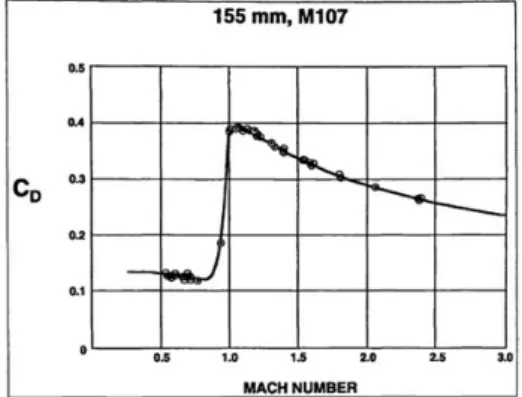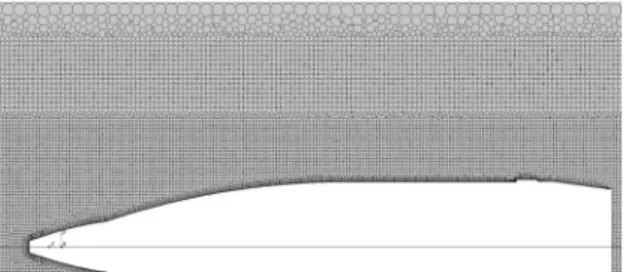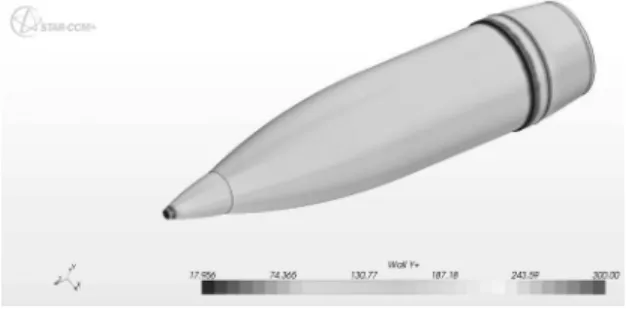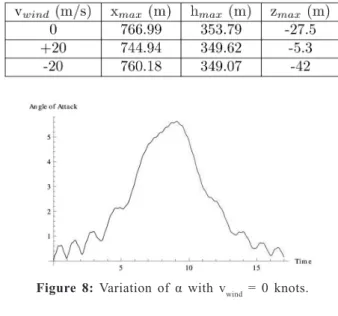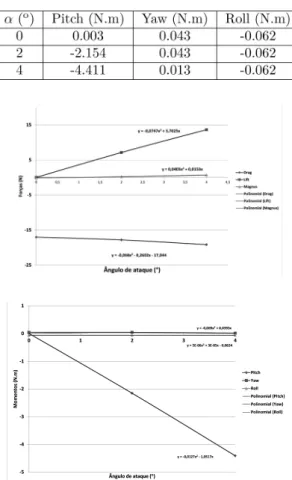AnAlysis of externAl bAllistics for A projectile of cAliber 155 mm Rui Fonte-Boa a1, José Borges a2, José Chaves b
a CINAMIL - Centro de Investigação da Academia Militar, Academia Militar, Lisboa, Portugal b Departamento de Engenharia Mecânica, Instituto Superior Técnico, Lisboa, Portugal
ABSTRACT
The objective of this thesis is to propose a geometry for a projectile to firefighting. The finite volume code STAR − CCM+® is used to
calcu-late forces and moments acting on the projectile and a code is created in MATHEMATICA® to define the characteristics of the trajectory. The
PRODAS® is used to verify and validate the models implemented.
Initially, the procedure adopted was to create an entire methodology for an existing ammunition that would allow be verified and validated with the available literature. An extensive aerodynamic characterization has been done through CFD in order to establish the projectile forces and moments behavior and thus feed the further 6 DOF computation. It was concluded that the locking strap, the guiding strap and the Coriolis drift were negligible compared to the results obtained. The implemen-tation of angle of attack came to influence the range and stability of the projectile. In the following phase six different geometries were tested, varying the lenght and the nose. Set up for this projectile an initial velocity of 100 m/s, 10 kg, concluding that the total length would be 697.1 mm and semispherical profile with the capacity to transport 7.5 dm3 inside. Wind tests were conducted to
evaluate the stability in flight, and the software and analysis process develo-ped in this work are available, being a contribution to the project FIREND.
Keywords: Projectile, angle of attack, stability, semispherical profile, center
of gravity.
1. INTRODUCTION
The occurrence of forest fires is something unavoidable. The means of firefighting used today by civil protection still have some gaps. Hence this FIREND project arose in 2005 (Lima, 2005) with the ultimate aim of providing an alternative and additional way to designed to forest fire fighting, having suffered its last upgrade in 2013 (Calado, 2013). This upgrade was to begin operating with a 155 mm projectile, instead of using 1 O presente artigo resultou do trabalho desenvolvido para a Dissertação de Mestrado elaborada pelo autor. 2 Email para contacto: jose.borges@academiamilitar.pt
a 105 mm, as had been done previously, having even gotten to do shooting tests in Vendas Novas. The main reason that justified this change was to increase the volume of material to be transported inside, which happened to be three times higher.
Overall this project consists of an artillery shell designed to fight fires, strengthening the action of the firefighters and Civil Protection. Its performance allows long distance firefighting and in areas of high slope and diffcult to access for terrestrial means and in situations with reduced visibility, nighttime as well as under adverse weather conditions sometimes preclude the performance of air assets. Still allows the military may have another type of missions in peacetime, with special interest for the entire population, which certainly contribute to raising their levels of motivation and to be recognized for their work performed on behalf of the population. This study aims to determine an unconventional geometry for a projectile to submit flight stability along its trajectory. This requires the use of CFD simulations, so that the coefficients of force and moment can be calculated, and also the pseudo-empirical prediction methods, as is documented in external ballistics literature. As a final goal we intend to build a simulation system consists of a coupling results from aerodynamic analysis with the calculation of the path with 6 degrees of freedom.
2. DESCRIPTION
For external ballistics be understood, it is necessary to take into account several factors, including the correct nomenclature, whether in English (Carlucci, 2007), whether in Portuguese (Dias, 2007).
Three reference frames were considered in the overall computations: • the referential X Y Z, static and located at the howitzer exit, as shown
in Figure ref fig: reference;
• the x’ y’ z’ referential, located in the CG of the projectile, is always aligned with the X Y Z referential;
• the x y z reference frame aligned with the body of the projectile and has the same spin movement as the projectile;
Using the ST AR − CCM+ is possible obtain the aerodynamic forces and moments acting on the projectile, and being the gravitational force known, the accelerations comes naturally from an algebraic operation. By definition
and thus
By numerical integration, after setting Δt as a constant, it follows that
Integration of equation 2 gives vi = dxi /dt, which after discretization provides us the equation of coordinate position xi of the body with time. Finally xinew
= xiold + Δt.v
iold gives the discrete equation of CG position.
The rotation motion is represented with three degrees of freedom, three angular coordinates which rep¬resent the body orientation in 3D space about its mass center. Θ = {φ, θ, ψ}, with φ the spin angle, θ the pitch and ψ the yaw angle. The orientation of the body is defined after three sequential rotations, in the previous order φ, θ, ψ relatively to the referential x’ y’ z’. To analyze the motion of the projectile is considered just the angle of attack, defined as the angle between the axis of the projectile and the flow direction of approach in the frame of ammunition. With no wind this direction will be the direction of the trajectory. The Euler equations of motion were used for the 3D rotation. These equations are written on a referential whose axis correspond to the principal axis of inertia. The referential is supposed to rotate with the body to keep unchanged the inertia moments. The equations are:
The subscripts B and R in the equation 4 represents the body and the frame, respectively, being Ṝ the rotation matrix.
The rotation matrix has 9 free variables, but considering the symmetry of the matrix, 3 of them are automatically set. Therefore remaining six variables to define three degrees of freedom of rotational movement in 3D. As such it will be necessary to reorthonor¬malize the rotation matrix.
The 6 DOF Model was used because it is the model that best represents the physical phenomenon of ballistic flight, when you want an overall assess¬ment, similar to what had been done in 2009 (Khalil, 2009), when effected studies to calculate the trajectory of a projec¬tile of 155 mm , resorting to the aid of the software PRODAS® to calculate the properties of flight.
The use of CFD methodologies to approach a problem is based on a very specific procedure. During the preprocessing, it is necessary to define the geometry of the object under study, as well as their domain, which is divided into discrete cells (the mesh) (Barata, 2009). The choice of the mesh to be implemented is very important because it will have a decisive role in the solution of diferential equations (Vianna, 2014). The CFD software allows to calculate the forces and moments at each time and report to the user (Sahu, 2005), which depend on the angle of attack (Garibaldi, 2007). It was found that the lift increases with the implementation of angle of attack, as well as the axial force due to the Magnus effect.
The spin stabilized projectiles for L/D ratio greater than 7 (L is the length and D the projectile’s caliber) tends to be unstable unless additional components are used to ensure stability (BlueCape, 2007).
There are several factors that effect the trajectory. They are: angle and launch speed, mass and shape of the projectile, atmospheric wind, effect of Earth’s rotation, forces and moments induced by rotation and weather effects (Carlucci, 2007). The velocity of the projectile has a direct influence on the resistance it others in flight (McCoy, 2012), illustrated in Figure 2.
To be acted whole approach described above will assume a set of hypotheses so as to simplify the entire process, i.e., it is assumed:
• gravity constant along the trajectory of the pro-jectile equal to 9,81 m/s2;
• the properties of the air are set for a standard atmosphere;
• it is considered that the projectile leaves with an¬gle of attack of 0 degrees and without applied forces;
• the Coriolis force was not considered due to its low influence to short ranges; • the surface of the projectile is considered smooth for the purposes of
friction and turbulence;
• it is considered that the CG of the projectile is constant, as well as the moments of inertia, along the path.
3. VERIFICATION AND VALIDATION
Initially it was assumed that the projectile would spin and worked in a subsonic regime because the towed howitzer designed to fire the projectile has a fluted tube, introducing rotation in the projectile, and able to act simultaneously with the Civil Protection firefighting, being necessary to achieve short distances so that it is as accurate as possible. Another reason was to establish a methodology for use in optimiza¬tion processes being the CD constant in the subsonic regime, having only that the drag climb as the square of speed and air density.
The case study for verification and validation was conventional ammunition
M107, illustrated in Figure 3, with their main characteristics in Table 1.
These tests were carried out to load 1 (minimum charge of gunpowder) which corresponds to a rate of translation and rotation.
Figure 3: M107 ammunition geometry. Table 1: Features with v = 211.8m/s e ω = 344 rad/s.
The mesh is a fundamental parameter for obtaining reliable results. After verified the convergence of the results for a number of cells of approximately 6.5M, figure 5, it was assumed that this would be the kind of refinement required to give an answer to the purpose, figure 4.
The error obtained for the value of CD compared with the value of CDteórico to 6.5M of a mesh cell, was less than 2%.
Figure4: Final mesh adopted.
Figure 5: Drag with the mesh refinement.
The physical model chosen for the CFD simulations in ST AR − CCM +8®
was Coupled Flow for being suitable for compressible flows (CD-Adapco, 2013). Another ad¬vantage of this model is the robustness to solve flows with dominant source terms, because the projectile has spin.
The turbulence model was used to model k − ω (SST version) for being suitable for situations of high adverse pressure gradient and flow rotation. In the boundary conditions of the wall was chosen high y+ (from 30 to 150), Figure 6, to prevent the mesh had more cells.
In Figure 6 can observe the representation of the y+ along the projectile. As can be seen the range for the values of high y+ was respected. There have been some exceptions for which it was not possible to guarantee the
Figure 6: Representation of y+.
Simulations were performed with 0, 2 and 4 degrees of angle of attack because variations of α in flight ammunition occur mostly in this range. These values will influence the range and stability of the projectile along its trajectory. It is important to note that the coeffcients of forces / moments were calculated at the CG of the projectile.
In the Figure 7 can clearly observe the influence of angle of attack on the projectile. For 0◦ angle of at¬tack can verify the symmetry of the turbulence in the wake unlike what happens at 4o, noting the variation of turbulence in the wake zone.
(a) 0o angle of attack.
(b) 4o angle of attack.
Figure 7: Variation of TKE.
To analyze the trajectory was used two softwares. Own implementation in MATHEMATICA® and PRODAS®, recognized ballistics commercial software,
integrating the CFD results in the study of rigid body dynamics. Established a comparison between the values of firing tables with the values ob by different software in order to verify and validate the code implemented in MATHEMATICA®. The results are shown in Table 2.
As already mentioned, the MATHEMATICA® was used due to their valencies.
A code was created so that the trajectory of the projectile could be cal¬culated at any instant of time. There was need to create this code to complement the results obtained with the PRODAS®, but mainly because the operating
conditions of the new projectile can not be satisfied with this software because, for example, the future launch speed is Mach 0.3, much lower than the typical values of speed used, and this software makes interpolations of experimental data. The other reason is the fact that the geometry can no longer be con¬ventional and in this case, PRODAS® also not be suitable, although
it is useful when it is possible to apply, making the process much quicker. However the code created in MATHEMATICA® was also verified and validated
with PRODAS®, using for this a speed of 200 m/s and a conventional geometry,
which by the way exists in the software library. Thus it was possible to compare the results obtained with both software, those results being shown in Table 3.
Table 3: Comparison of the results obtained.
As can be seen from the results presented, both results are very similar, thus being verified and validated the code.
4. RESULTS
Some initial conditions that have a major role in the design of the projectile and scope of the intended purpose were imposed. These are shown in Table 4, together with the conditions for conventional ammu-nition M107 by way of comparison.
The initial rate and the total mass of the projectile have undergone significant changes. These aim to conceive the projectile FIREND with a material which makes the entire process more economical and that the pressures and temperatures developed inside the shell are much lower, so that the new material supports them. 6 were created and analyzed geometries, varying the total length of the projectile and the shape of his nose. The first 3 nosecone versions have a varying length, while the other have a hemispherical nose, Table 5.
Table 5: Different geometries tested.
Both parameters that were changed have the same purpose: to increase the ability of material to be transported inside the projectile, when compared with conventional M107 ammunition.
The idea of the nose being hemispherical dates back FIREND 105 mm since, for the same total length of the projectile, the material to be transported increases about two times more by abandoning the idea of conical profile, has always adopted in conventional munitions.
In order to test and to establish a comparison between different geometries, some parameters remained unchanged. The speed used was 100 m/s and tested simulations into a launch angle of 60º, as it is more susceptible to the instability of the projectile. However it should be noted that other parameters such as the total length, CG, CP, undergone changes in geometry to geometry, these parameters also have a leading role in the stability analysis of the projectile.
Based on tests performed for six different geometries in order to select the geometry that best fulfilled the requirements for the new projectile FIREND of 155 mm, was selected geometry version 4. It was found that this is the most stable geometry by analysis of the variation of the angle of attack during the trajectory, compared with various geometries analyzed for different wind speeds, and also according to the value of the registered gyroscopic stability. The results obtained are shown in Table 6.
In Table 5 it can be seen that the parameter of gyroscopic stability is only satisfied for three versions created, being version 4 one of these. Is this that provides a greater capacity to carry material inside and therefore, with regard to this aspect, the better choice.
Table 6: Different limits as a function of wind speed
for geometry version 4.
Figure 8: Variation of α with vwind = 0 knots.
Figure 9: Variation of α with vwind = +20 knots.
For this geometry the angle of maximum attack achieved in a situation without wind, never exceeds 5.6º, while in a situation where there is the presence of a crosswind magnitude of 20 knots the angle of attack already reaches values of 10º. However these maximum are achieved when the projectile starts its descending phase in the trajectory, when the travel speed of the projectile registers its minimum, then returning to low values of angle of attack. It means that their behavior back to stabilize in the stage prior to his arrival to the ground. The variation of angle of attack along the trajectory can be seen in Figures 8, 9 and 10.
In Figure 11 can observe the new location of the CG and CP in geometry version 4.
Figure 11: FIREND 155 mm geometry with CP and CG.
Using the software STAR − CCM+® , all simulation methodology developed
for conventional ammunition M107, in the previous chapter, was applied in this new configuration of the projectile, ie, in the FIREND 155mm geometry. Thus, the final mesh got approximately 7M cells, present in Figure 12, like the mesh implemented for the M107 ammunition in the previous chapter. Also the parameters implemented in STARCCM+8® were the same.
Figure 12: Mesh used in FIREND 155 mm.
With the results of the aerodynamic characteris¬tics for the three angles of attack analyzed (0º,2º and 4º), under the conditions imposed, were traced characteristics curves of forces and moments acting on the projectile in order to observe the tendency of the same. These results are shown in Tables 7 and 8 and the characteristics curves are shown in Figures 13. It is important to note that the moments were calculated at the CG of the projectile. As can be seen, in Figure 13, increasing angle of attack causes large changes in the lift and in particular in pitch, by varying these parameters
in an approximately linear way. In the case of the lift, which for 0º angle of attack was virtually nil, at 4º shall be of considerable value. The same goes with the pitch, result of pressure distribution along the projectile.
Table 7: Results of forces with α.
Table 8: Results of moments in the CG with α.
(a) Forces with α.
(b) Moments with α.
Figure 13: Variation of the forces and moments with α.
Similar to the analysis performed for the trajectory of the projectile with launch angle of 60º, after having defined the final geometry to adopt, also
conducted tests for other launch angle, especially for 30º and 45º. As was done previously, it was now found the influence of wind at 20 knots in projectile either in the positive direction, whether in the negative sense. The results are shown in Table 9.
Table 9: Limits to wind for FIREND 155 mm with β = 60º.
5. Conclusions
The main conclusions are the following:
• The value of the forces and moments acting on the projectile depend significantly on the angle of attack. For α = 0º all moments and forces are practically inexistent, except drag and roll;
• The maximum angle of attack reached by the projectile along its trajectory is directly dependent on the launch angle;
• It was found that it would not be possible to increase the length of the projectile, ensuring its stability in flight as described in the literature. • For the initial conditions imposed for the release of the projectile, the
hemispherical profile is more stable than the conical profile. With this new profile in addition to respect the stability parameter, also sig¬nificantly increases the amount of load to be carried inside the projectile;
• Were also carried out simulations taking into account the wind speed and it was concluded that the most critical situation in order to unsettle the flight of the projectile is to crosswind with positive direction. It was shown that the 155 mm projectile FIREND would be more likely to unsettle when subjected to wind than the M107;
• It was also concluded that the lateral deviation suffered by the projectile has a strong dependence on the time of pitch, and the higher the value the first derived of this moment, lower the amount of lateral deviation of the projectile. It also presents some in-fluence in variation of the angle of attack so that the larger the lateral deviation greater will be the varia¬tion of angle of attack. • Was established a process, verified and validated, which allows to characterize in a structured and se¬quential way the specificities of a munition with regard to external ballistics. This methodology will be of great importance
in future developments of the project. It should be noted that even if this form is considered, many other aspects such as the interior of munition or the material which is manufactured have implications in the mass, in moments of inertia, in CG, among others.
• According to the methodology and parameters defined, is expectable get results aerodynamic and ex-ternal ballistics lower than 2%.
REFERENCES
F. Lima (2005). “Desenvolvimento de munições de artilharia para combate a incêndios florestais”. Master Thesis, Portuguese Military Academy and Instituto Superior Técnico, Lisboa, Portugal.
J. Calado (2013). “Projeto de um projétil de calibre 155mm para combate a incêndios florestais”. Master Thesis, Portuguese Military Academy and Instituto Superior Técnico, Lisboa, Portugal.
D. Carlucci and S. Jacobson (2007). “Ballistics: Theory and Design of Guns
and Ammunition”. Taylor & Francis.
E. Dias (2007). “Desenvolvimento do conceito, fabrico e ensaio de um projéctil mecânico para combate a incêndios florestais: Firend”. Master Thesis, Portuguese Military Academy and Instituto Superior Técnico, Lisboa, Portugal. M. Khalil (2009). “Dispersion analysis for spinning artillery projectile”. Proceedings of the 13th International Conference on Aerospace Science &
Aviation Technology. Military Technical College, Kobry Elkobbah, Cairo, Egypt.
R. Barata (2009). “An approach to ventilation design application to Loures Shopping case”. Master Thesis, Instituto Superior Técnico, Lisboa, Portugal. A. S. Vianna Jr, F. de Siqueira, L. R. Quintal and A. L. S. Lima (2014). “CFD e a defesa química”. Revista Virtual de Química, vol. 6, no. 3, pp. 815– 832. J. Sahu (2005). “Advanced Coupled CFD / RBD Calculations of Free - Flight
Projectile Aerodynamics”. Proceedings of the 2005 Users Group Conference,
IEEE Computer Society. Washington, DC, USA.
J. Garibaldi, M. Storti, L. Battaglia and J. D’Elia (2007). “Numerical simulations
of the flow around a spinning projectil in subsonic regime”. Latin American
BlueCAPE (2007). “Trajectory analysis of a spinning projectile”. Technical Report from BlueCAPE, Lisbon, Portugal.
R. McCoy (2012). “Modern Exterior Ballistics: The Launch and Flight Dynamics
of Symmetric Projectiles”. Schiffer Publishing, Limited. Pennsylvania, USA.
CD-ADAPCO (2013). “Star-ccm+ user guide, version 8.02”. Computational Dynamics-Analysis & Design Application Company Ltd, Melville, NY, USA. Rui Fonte-Boa is a Lieutenant from the Ordnance Corps of Portuguese Army. He holds a Master degree in Military Mechanical Engineering from the Portuguese Military Academy.
José Borges holds a Professor position with the Portuguese Military Academy where, among several teaching and administrative duties, he is Scientific Coordinator of the Military Mechanical Engineering Master course. He is a Research Associate with CINAMIL.
José Chaves is an Assistant Professor with the Mechanical Engineering Department from Instituto Superior Técnico. He develops his research activities with IDMEC - Institute of Mechanical Engineering.

